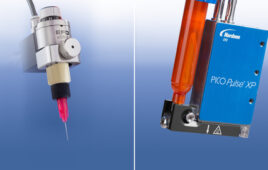Written by Simla Ay
Technical Marketing Writer | Hernon Manufacturing
Threadlockers are adhesives designed to lock, seal, and hold threaded fasteners in place after tightening. They have a wide range of applications including for industrial equipment, engine, pumps, generators, electronic devices, and many others. Any threaded assembly expected to encounter vibration will need a threadlocker to meet best-practice standards.

Sealing bolted joints with threadlockers.
A variety of mechanical fasteners are also used to lock threaded assemblies in place. Some of these conventional methods are double nuts, split washers, nylon nuts, or toothed flanged bolts. These mechanical fasteners are simple and effective but require manufacturers to inventory additional or specialized parts.
One challenge with using mechanical fasteners is that they add weight to an application and are typically more difficult to apply on an industrial scale or assembly line. Unlike chemical threadlockers, which offer several unique features, mechanical fasteners may rust if the metal quality is low and this can damage product functionality and aesthetics.
Threadlocker adhesives circumvent these challenges by forming a bonded thermoset plastic to fill the gaps between threads of assembled parts. This filling seals a leak pathway, ensuring unwelcome liquids stay out of the threads and prohibit any penetration of the bolt hole.
Threadlockers adhere to the male and female threads across an entire surface area of the mating parts, using all of the space to maintain a powerful bond. In addition to holding the assembly in place, the cured thermoset plastic provides some flexibility to tolerate thermal and cycling while offering an inert barrier that resists galvanic corrosion.
How do threadlockers work?
Threaded assemblies keep a tight joint by maintaining tension between the male and female threads. The friction of the threads resists the loosening of the assembly. However, exposure to vibration and shock will lead to assembly loosening. Between threads of the nut and bolt, there’s an approximate range of 15% metal-to-metal contact. This is the area of friction and the remaining 85% of the threads are not in contact.
Threadlockers fill this gap, bonding to the surfaces and significantly increasing the area of friction between the mated surfaces.
Before the application of a threadlocker, the male and female threads should be clean, dry, and free of corrosion. After cleaning the threads, a very small amount (often just a single drop) of threadlocker is applied on one side of the first three threads of the bolt. When the fastener is tightened, the rotation of these threads spreads the threadlocker on them. It will also coat the female threads as the bolt screws into the nut.
As the assembly tightens, the threads bear down on one another, excluding oxygen and leaving only a small amount of liquid threadlocker. This anaerobic environment — meaning the absence of free oxygen — triggers threadlocker curing and the threaded assemblies are locked into place.
How to choose a threadlocker?
There are several factors to consider when choosing a threadlocking adhesive including strength, size, and formulation.
Strength. Threadlockers are available in a variety of strengths. Each strength is denoted by color. Low-strength threadlockers are purple or have a purple stripe on their bottle. Medium-strength is typically blue and high-strength is red. These color associations are so strong that longtime threadlocker users will often refer to their desired product by color rather than strength, grade number, or even brand.
Size. Fastener size is an important consideration in relation to the strength and viscosity required for use in an application.

Several different types of threadlockers.
For example:
• Screws that are less than one-quarter inch in diameter, such as calibration screws or gauges, are typically locked by low-strength formulations.
• Fasteners up to three-quarters of an inch in diameter, such as those used in pumps or compressors, are generally fastened by medium-strength formulations.
• High-strength threadlockers are most often used on fasteners between three-quarters of an inch, up to one inch in diameter — and usually used with heavy equipment.
Formulation. The formulations offer different features. Low-strength formulations, for instance, are easy to remove. They provide low-strength bonds that can be disassembled by hand or with basic tools. If disassembly is routinely required, low-strength threadlockers should be used to minimize the wear on the bolts and effort required from an end-user.
Medium-strength grades can be removed using hand tools such as a wrench or vise-grip. High-strength threadlockers are used for permanent bonds, offering the highest bonding capabilities. If users want to disassemble a bonded fastener, high heat and power tools are necessary.
The application
The application method is also a significant factor when selecting a threadlocker. If applied during the assembly, either low, medium, or high-strength grades are used. However, if a project requires a threadlocker to be applied to parts that are already assembled, wicking grades avoid the need to disassemble and reassemble all the fasteners.
A wicking threadlocker is a low-viscosity liquid for penetrating and locking pre-assembled parts. Wicking capabilities are used where penetration into fastener connections is required and disassembly is undesirable or not an option. The product moves between fastened threads by capillary action.
This unique application method is associated with the color green to differentiate from the other common threadlocker varieties. Localized heating and hand tools are needed for disassembly.
Automatic dispensing systems are regularly used to apply generic threadlocking adhesives on parts for immediate assembly. But some manufacturers may want to hold treated parts for assembly later or at an alternate location, such as a jobsite. For this capability, manufacturers should look for pre-applied threadlockers.
Pre-applied threadlocker products incorporate a chemical activator into their makeup through a process called microencapsulation. The microencapsulation process is a method in which tiny amounts of an activating agent is stored within a shell or bead. The core material is isolated during storage and released during the assembly process.
Due to the micro-beads and inactivated material, pre-applied threadlockers offer a high-viscosity paste-like consistency. To apply this material, it’s necessary to wipe the paste onto the male threads. Once a small amount evenly coats the male threads, parts can be transported or stored for months before use.
Once assembled, the micro-capsules with the activator will break because of the pressure or shearing force from the joining threads. Then, the adhesive and the curing agent will interact and polymerization begins. Contact between the two materials initiates the chemical curing process.

Pre applied self-sealing fasteners.
Full curing typically results after 24 hours and can be accelerated by higher temperatures but this fixture time is usually just a few minutes.
The case for epoxies
In most cases, a clear threadlocker is used but there are exceptions. For example, in one case, a customer of Hernon Manufacturing needed to secure very large bolts that were over two inches in diameter. This customer had already tried typical threadlockers but the gaps between the threads were so large that the anaerobic curing process was unreliable.
In such specialized circumstances, other adhesives such as epoxies may be used to act as a threadlocker.
Epoxy is a thermosetting polymer that cures when mixed with a hardener. Epoxies have excellent adhesion and they are extremely resistant to heat and chemicals. They are typically thick, messy to apply, and bond so securely that they make a poor choice for general threadlocking use.
However, they can fill significant gaps, which made them useful in this case. They’re also chemically activated and need not rely on anaerobic properties to cure. As such, they can be a good choice for unique projects — and large bolts.
For this application process, the two-part epoxy system is mixed and then applied to the male and female threaded parts. The chemical curing reaction starts as soon as the two parts are mixed, so users have limited time to secure the bolts in place.
An important note: bolts bonded in place with epoxy will be exceptionally difficult to remove.
Custom formulas
In rare cases, off-the-shelf threadlockers are a less-than-ideal match for an application. This is typical when temperature extremes are a concern, such as with cryogenic products. It can also occur if the nut and bolt substrates for a project are made with atypical materials, are coated, or have an unusual shape and will not bond to traditional threadlockers.
For such projects, it’s possible to have a custom formula designed for the application. To support the development of a custom formula, it’s recommended to ensure that your estimated yearly usage will absorb the cost of the R&D.
Contact your adhesive manufacturer to discuss your application.





Tell Us What You Think!